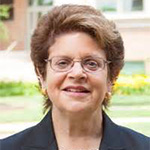Helping Our Candidates Become Better Communicators

A Conversation With Harriet “Niki” Fayne, Dean of Education at Lehman College
Harriet “Niki” Fayne, dean of education at Lehman College (City University of New York) in the Bronx, isn’t about to say that edTPA was easy for her faculty and students, or that it is the final answer for teacher preparation. But she does say this: edTPA moves the profession in the direction of strengthening the skills of beginning teachers.
“The edTPA validates our work. Without a common standard, the public is not going to believe what we say about our candidates or programs,” says Fayne. “People want very clear metrics that they can understand. Embedded in the edTPA is qualitative information about candidates. Scores serve as a way to communicate results.”
Lehman College is working hard to reverse high teacher turnover rates in local Bronx schools by preparing teachers to work in the same neighborhoods where they grew up. But it’s not easy. Lehman students often are the first in their families to attend college; many work full-time or are single parents.
So when New York required all teacher candidates to take and pass edTPA last spring, Lehman’s faculty recognized that there were high stakes for their students and themselves. They moved quickly to understand the new requirements and provide supports to students to not only pass edTPA, but more importantly, become better teachers in the process.
“My objective is to get our graduates, who look like kids in the Bronx, to work in the Bronx. What motivates us is to make sure our candidates become teachers,” Fayne says. “We’ve made a Herculean effort to embrace new requirements, analyze edTPA, back-map to it, and support students. All of this is really great news.”
Lehman took immediate steps, such as informing partner schools about the new performance-based requirements, establishing full-day training sessions for 2014 spring semester student teachers and field supervisors, purchasing “camcorder bundles” to lend to student teachers, and creating a dedicated web page with technical support documents.
Fayne and her faculty would have liked to have seen a higher pass rate last spring. She said the 62% pass rate does not mean that the other 38% would be poor teachers. “Yes, sometimes it feels as if we are on ‘Survival Island,’” she said. “But we need to be clear about why we should survive. We must provide our candidates with the opportunity to realize their potential and to sharpen their thinking and communication skills.”
More importantly, a deeper analysis of the candidate data provided by edTPA in core areas of teacher preparation showed that the outcomes made sense. “In that 38% are some promising preservice teachers, but they are also individuals who need to be savvier about following directions, describing how they make instructional decisions, and selecting an appropriate learning segment,” she added.
“Great preservice teachers can do poorly on the edTPA because they are not used to communicating with an external audience,” said Fayne. “This is not just about passing a test, though. It’s about asking, ‘“Can I be precise about what I’m doing and why?’ That’s what matters.”
Since the first round of statewide use of edTPA, Lehman has further strengthened its support for students and faculty, drawing from the extensive first-year data.
Today, early field experiences that are part of every program are shifting from unstructured opportunities to observe students and try lessons to “dress rehearsals” for student teaching.
Lehman faculty members also talk about edTPA data in small groups to make stronger connections between scores and how they are teaching. Instructors who are particularly strong in academic language or student assessment conduct mini-workshops on these topics for candidates and their peers.
“It’s a flashlight that lets you see cobwebs that you otherwise can’t see,” Fayne continues. “Let’s use this kind of systematic inquiry not to see if we are good or bad, but to see if we think our students are doing their best work.”
Lehman also has used federal Race to the Top funds to ramp up on student services. Under the careful supervision of Education Technology Coordinator Leslie Lieman, labs are open 4 days a week so that support is available when students need it. And who helps staff the labs? CUNY students and, for two short-term design projects, graduates who have passed edTPA.
“These are dedicated, economically marginal students who are working together more than ever in labs to meet new demands,” Fayne says. “They are happy to help one another. They hope they get jobs together. They will teach in challenging buildings and want to establish a support network.”
Fayne is frank about the potential for edTPA to advance ambitious teaching and learning.
“I’ve always believed in performance assessment. Can I raise objections about some of the technical aspects of the edTPA? Yes,” she adds. “Do I believe it’s better than paper-and-pencil alternatives? Yes. Better than open-ended observations that lend credence to the Lake Wobegon effect? Yes.”
Tags: AACTE partner organizations, assessment, school-university partnerships






